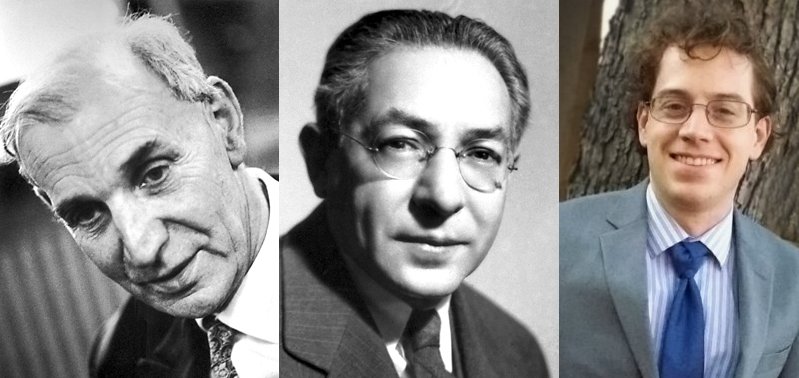
I have been exposed to a lot of odd ideas over the years: the flat earth, the idea that we never landed on the moon, chemtrails, etc. etc. Well, I can now add another to the list. This one comes from Answers in Genesis (AiG), which is warning Christians about the dangers posed by Young Earth Evolutionists. If you looked at those three words and said “What?”, I don’t blame you. Obviously, there is no such thing as a young-earth evolutionist. Evolution (at least in the sense most people use the term) requires billions of years, so if you are an evolutionist, you cannot believe in a young earth.
What does AiG mean by “young-earth evolutionist”? Apparently, it’s a young-earth creationist who is unwilling to pledge fealty to AiG’s tests of orthodoxy. Consider, for example, Dr. Todd Wood, who has a Ph.D. in biochemistry and was once the director of bioinformatics at Clemson University’s Genomics Institute. He is a committed Christian, a knowledgeable creationist who has done original research in the field, and an expert in baraminology, the scientific study of what kinds of living organisms were originally created by God. He believes (and teaches) that the days listed in Genesis 1 were roughly 24 hours long, that there was a worldwide Flood that is responsible for most of the fossil-bearing rocks we see today, and that the land animals we see today (with the possible exception of many kinds of insects) are descended from the animals that walked off the Ark after the Floodwaters receded. In short, he is a young-earth creationist.
Why does AiG call him a young-earth evolutionist? Because he is being honest about the data related to origins. For example, AiG takes issue with his famous statement that there are “gobs and gobs” of evidence for evolution. AiG doesn’t like this, because it claims that all this supposed evidence has already been “dealt with,” so none of it qualifies as actual evidence. While the first part of this statement is true, the second part is clearly not, and that goes to the core of the difference between AiG and many serious creation scientists. Yes, creationists have “dealt with” data that seem to support evolution. However, as any serious scientist understands (and AiG gives lip service to), scientific data require interpretation. Yes, creationists can interpret data in a way that is consistent with their ideas, but evolutionists can interpret that same data in a way that is consistent with their ideas. AiG seems to think that once creationists have figured out a way to interpret the data in a manner consistent with their ideas, the data no longer qualify as evidence for evolution. That is simply not true!
Anyone who has spent any significant amount of time seriously studying science understands that there is often no way to decide which interpretation of the data is correct. Often, one side’s interpretation of the data seems desperate, but that doesn’t mean it is wrong. Let me give you two examples. First, consider the GULO pseudogene. Evolutionists think that it is a broken version of a gene that was originally functional in early mammals, but mutations rendered it nonfunctional during the course of evolution. Well, the same mutations that are thought to have rendered it nonfunctional in apes are also found in humans. This is thought to be excellent evidence that humans and apes have a common ancestor whose gene had already been rendered nonfunctional, and that nonfunctional gene was passed on to both apes and humans. It’s true that the most straightforward way to interpret the GULO pseudogene is through the lens of common ancestry. Now, of course, there are ways to interpret it in the context of young-earth creation, and I give one of them in the link above. However, if you read it, you can see that it is not the most straightforward interpretation of the data.
Next, consider the phenomenon of homology. Many very different organisms share very similar features. All vertebrates (animals with backbones), for example, have the same basic plan for their forelimbs. Evolutionists assure us that this is because all vertebrates evolved from a common ancestor that passed on its forelimb plan to each of its descendants. In other words, homology is the result of common ancestry. However, there are many, many examples of similar structures that cannot be the result of common ancestry, because evolutionists have decided that those organisms don’t share a common ancestor that could give them that structure. As a result, they say that in such cases, homology is not a result of common ancestry. In other words, sometimes homology is a result of common ancestry, and sometimes it is not. That’s not a very straightforward interpretation of the data. A better interpretation of the data is that organisms were originally made by the same Designer, who simply used the same basic design over and over again when it was appropriate.
So….is the GULO pseudogene evidence for a common ancestor between apes and humans? Absolutely yes! Can creationists accommodate the GULO pseudogene in their view? Yes, but it seems a bit desperate. Is homology evidence for a common Designer? Absolutely yes! Can evolutionists accommodate it in their view? Yes, but it seems a little desperate. To any serious scientist out there, this shouldn’t seem strange. In every field where there are competing theories, those who support one theory have a set of evidence that is very strong, and those who support a competing theory have another set of evidence that is very strong. Typically, both sides can accommodate the other side’s evidence in their theory, but often, that accommodation seems desperate. Indeed, we often make decisions between scientific theories by deciding which one seems the least desperate when dealing with all the data!
Not only does AiG hate admitting that there is evidence for any view that disagrees with its own, it really hates the way Dr. Wood explains how he personally deals with the “gobs and gobs” of evidence for evolution. He says that he has faith. It’s rather odd for a creationist organization to argue against faith, but that seems to be what AiG is doing! It claims that in emphasizing his faith, Dr. Wood comes very close to fideism, which says that faith is opposed to reason. Of course, this is a gross mischaracterization of Dr. Wood’s views, and anyone who has honestly read Dr. Wood’s work understands that.
In fact, you don’t even have to honestly evaluate his work to see that AiG is mischaracterizing Dr. Wood’s views. You just have to go to YouTube and see his 12-minute video about why he is a creationist:
I really encourage you to watch the entire video, because it shows how a serious creationist honestly deals with evidence that seems to contradict his view (he specifically mentions one piece of data and vaguely refers to another). In case you do not, however, let me summarize what he says. Like any real scientist, he says that he is comfortable not having an answer to every question related to origins. As a result, his faith can remain strong despite challenges to it, which allows him to work towards finding answers to those challenges.
Now please note that I do not agree with everything Dr. Wood says. In fact, I disagree with his idea that there are “gobs and gobs” of evidence for evolution. Based on my interpretation of the data, I find that there is some evidence for evolution (which is why serious scientists can believe in it), but the “gobs and gobs” of evidence support the creationist view. However, I am also humble enough (despite what my students might say) to admit that I could be wrong. Thus, I value Dr. Wood and his contributions to creation science. In fact, I thank God for what he is doing!
Please note that AiG calls other very serious creation scientists “young-earth evolutionists.” I plan to address that in at least one more article.

 As I mentioned in my
As I mentioned in my 